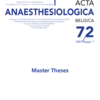Retrospective analysis of postoperative pain after general anesthesia for vitreoretinal surgery with or without a retrobulbar block
Vitreoretinal surgery; retrobulbar block, analgesics; postoperative analgesia
Published online: Apr 20 2022
Abstract
Objective: In ophthalmic surgery, postoperative pain is mostly ignored, or its importance is undervalued. This retrospective study aims to evaluate the effect of the intra-operative administration of a retrobulbar block on postoperative pain in patients undergoing eye surgery under general anesthesia. Postoperative pain scores were assessed at different time intervals (0, 4, 8, and 12 hours respectively), dose, and the number of administered analgesics postoperatively. The number of intra-operative antiemetics and the need for postoperative antiemetic administration was also evaluated.
Methods: A retrospective observational study was performed in adult patients undergoing vitreoretinal surgery under general anesthesia between July 1st , 2019, and January 1st, 2020. We identified 77 patients receiving only general anesthesia (RB- group) and 176 patients who received a retrobulbar block in addition to their general anesthesia (RB+ group). Our primary outcome was the postoperative numeric pain rating scale (NPRS) assessed at different time points (0, 4, 8, and 12 hours respectively). As secondary outcomes, the dose and number of postoperative administered analgesics, the number of intraoperative antiemetics and the need for postoperative antiemetic rescue medication, and the incidence of technique-related complications were evaluated.
Results: Mean NPRS scores of the RB- group were slightly higher compared to the RB+ group. However, none of these differences were statistically significant at the different time intervals (p values at each time point: T0= 0.13, T4= 0.89, T8= 0.17, T12= 0.63). Groups did not differ with respect to overall analgesic consumption, need for antiemetics, or complications.
Conclusion: The results of this retrospective study revealed no significant benefit of supplementing a retro-bulbar block on top of general anesthesia in vitreoretinal surgery. Therefore, the application of this technique remains a joint decision of the surgeon, anesthesiologist, and patient in which postoperative analgesia is not a determinant factor.
